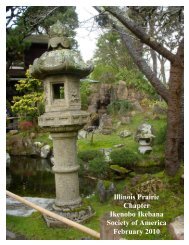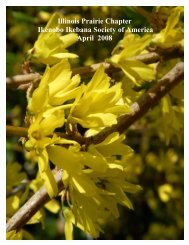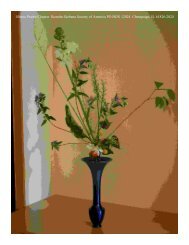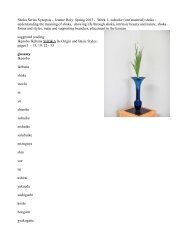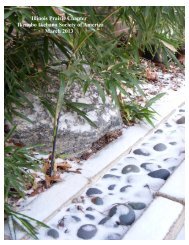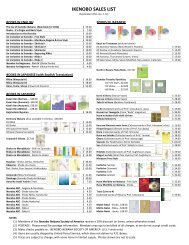June 2008 - Illinois Prairie Chapter - Ikenobo Ikebana Society of ...
June 2008 - Illinois Prairie Chapter - Ikenobo Ikebana Society of ...
June 2008 - Illinois Prairie Chapter - Ikenobo Ikebana Society of ...
Create successful ePaper yourself
Turn your PDF publications into a flip-book with our unique Google optimized e-Paper software.
<strong>Ikenobo</strong> <strong>Ikebana</strong> <strong>Society</strong> <strong>of</strong> America<br />
<strong>Illinois</strong> <strong>Prairie</strong> <strong>Chapter</strong><br />
Spring <strong>2008</strong><br />
<strong>Ikenobo</strong> <strong>Ikebana</strong> <strong>Society</strong> <strong>of</strong> America
<strong>Illinois</strong> <strong>Prairie</strong> <strong>Chapter</strong> <strong>of</strong> the <strong>Ikenobo</strong> <strong>Ikebana</strong> <strong>Society</strong> <strong>of</strong> America<br />
The Arranger<br />
2303 Seaton Court, Champaign, <strong>Illinois</strong> 61821-6623 <strong>June</strong>, <strong>2008</strong> issue<br />
Workshops with Visiting Senior Pr<strong>of</strong>essor Midori Katoh<br />
Spring this year was like living in the middle a symphony composed <strong>of</strong> every flowering beauty. Forsythia,<br />
daffodil, tulips, quince, cherry (front page),<br />
magnolia, crab apple, and prunus, to name a<br />
few, all bloomed together. It was like living<br />
in the middle <strong>of</strong> a oil painting that also<br />
accosted your sense <strong>of</strong> smell. Near the end<br />
we could wade through magnolia blossoms<br />
that lay ankle deep around their tree trunks.<br />
About that time Visiting Pr<strong>of</strong>essor Midori<br />
Katoh came to Japan House and inspired us<br />
with her teaching <strong>of</strong> shimputai rikka and a<br />
special freestyle workshop.<br />
Pr<strong>of</strong>essor Katoh with <strong>Illinois</strong> <strong>Prairie</strong> <strong>Chapter</strong> members at Japan House<br />
ABOVE(left) Pr<strong>of</strong>essor Katoh with Treasurer Carol Lyke in front <strong>of</strong> the west window view <strong>of</strong> the Japan House tea garden (center) The pr<strong>of</strong>essor<br />
critiques a freestyle while Gunji Sensei and Ann Chan look on – east view <strong>of</strong> gravel garden (right) Pr<strong>of</strong>essor Katoh’s freestyle<br />
BELOW(left to right) Shimputai Rikka by Jeanne Holy, Kesami Holmes, Betty Lankford and Maribeth Price.
Members pose with their relief freestyle<br />
L-R Nancy Allen, Susan Haney, Maribeth Price, Carol Lyke,<br />
Barbara Warters, Bruce Barr, Margy Barr, Midori Katoh, Jane Mangrum, Aurora Villacorta, and Virgie Young<br />
L-R<br />
Ann Chan, Joan Volkmann, Robin Dodson, Donna Gahwiler, Pr<strong>of</strong>essor Katoh, Betty Lankford, and Al Marx<br />
Each year <strong>Illinois</strong> <strong>Prairie</strong> <strong>Chapter</strong> participates<br />
in the Krannert Art Museum fundraiser “Petals<br />
and Paintings.” The completed Shimputai Rikka<br />
(by Kimiko Gunji, Jeanne Holy and Virgie<br />
Young) is shown (far left) in front <strong>of</strong> the<br />
painting “our Home at the End <strong>of</strong> the World”<br />
by Paul Sierra. Purple mirrored plexiglass was<br />
used under the arrangement producing<br />
interesting lighing effects on the wall as well as<br />
bringing the actual painting into closer<br />
proximity (near left closeup). The container,<br />
materials, colors and shapes were all chosen in<br />
response to the painting.
<strong>Illinois</strong> <strong>Prairie</strong> <strong>Chapter</strong> Summer <strong>2008</strong> Workshop Reservation Forms<br />
<strong>June</strong> 14 - Shoka Sanshuike<br />
(Reservations due by <strong>June</strong> 13, <strong>2008</strong>)<br />
9:30 am - 12:00 pm<br />
Please bring your own floral materials and a<br />
shoka style container, gravel and an ashi<br />
kenzan. Some line material will be provided .<br />
Name: ____________________________<br />
( ) Member : $10 ( ) Guest : $20<br />
July 12 - Freestyle<br />
(Reservations due by July10, <strong>2008</strong>)<br />
9:30 a.m. – 12:00 p.m.<br />
Please bring your own materials, container,<br />
wire, tape, and wire cutters.<br />
Name: ____________________________<br />
( ) Member: $10 ( ) Guest: $20<br />
August 9, <strong>2008</strong> – Shimputai Shoka<br />
(Reservations due by August6, <strong>2008</strong>)<br />
9:30 am - 12:00 pm<br />
Please bring your own floral material, shoka<br />
style container and kenzan.<br />
Name: ____________________________<br />
( ) Member: $10 ( ) Guest: $20<br />
Challenge yourself this summer by bringing your<br />
own material to the workshops. The abundant rain<br />
has provided us with a wide choice <strong>of</strong> floral<br />
materials in our yards and at the farmers market.<br />
When cut material does not survive, it is most likely<br />
due to a lack <strong>of</strong> water. Part <strong>of</strong> the flower way is to<br />
arrange with our legs; to challenge ourselves. Search,<br />
find, cut, and condition materials. Here are some<br />
tips…<br />
Cut materials in the early morning, after plants<br />
have had a chance to drink all night long. If you can<br />
cut in the rain your materials will be very happy.<br />
Have a bucket <strong>of</strong> warm water available for<br />
woody materials and grass materials.<br />
Some trees condition better with a little sugar in<br />
the water – like Japanese maple and prunus.<br />
Weedy materials enjoy vinegar added to the<br />
warm water, Queen Ann’s Lace for example.<br />
When cutting, ask yourself how you will use the<br />
material in the particular style you will arrange. For<br />
example is this sh<strong>of</strong>utai? Consider what is the sunny<br />
side and shady side, topside, bottom, and how the<br />
plant grows in its natural habitat. Cut accordingly.<br />
For woody materials, make several cuts across<br />
the bottom, or peel back a little bark to help it take<br />
up water. For hollow plants like Dahlia – mash the<br />
end <strong>of</strong> the stem to avoid air being trapped,<br />
preventing water absorption.<br />
Let your materials condition overnight. Cut extra<br />
so that if something doesn’t condition you will have<br />
enough, and so that you can share at the workshop.<br />
When you purchase materials at the flower shop<br />
or farmers market, be sure to recut the stems and<br />
condition overnight if possible. Use commercial<br />
flower conditioner if provided.<br />
We learn by doing, so don’t be afraid to<br />
experiment, to make mistakes, to try something new.<br />
Challenge yourself!<br />
All workshops will be held at Japan House. If you<br />
need help in getting your material or have any questions, contact Jeanne Holy at 217-637-5221 or email to<br />
jholy@shout.net . Please return forms, checks and written correspondence to:<br />
<strong>Illinois</strong> <strong>Prairie</strong> <strong>Chapter</strong>, 2303 Seaton Ct. Champaign, IL 61821-6623



